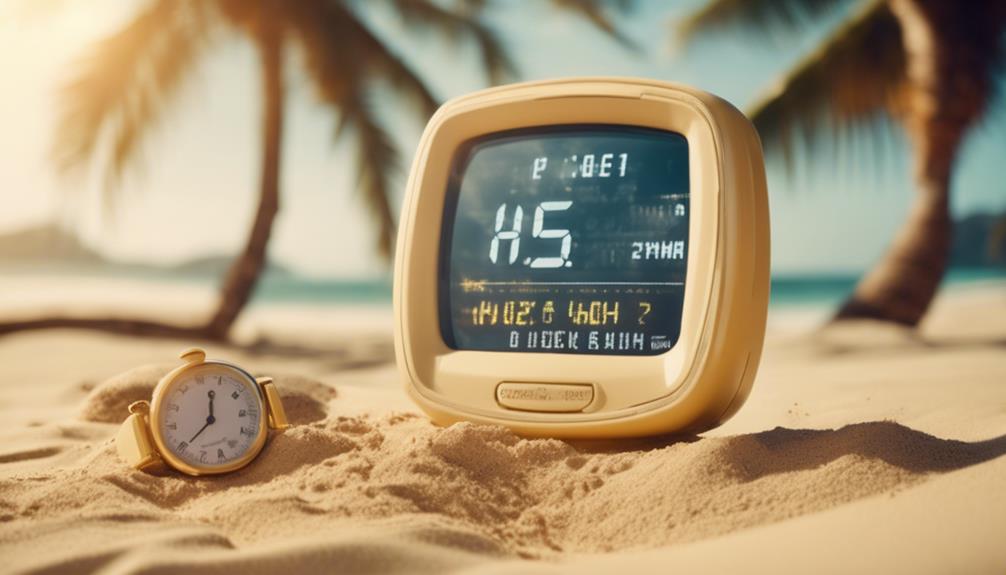Tanning can give you a beautiful glow, but protecting your skin health is crucial. Begin by identifying your skin type – this will help you determine how much sun exposure you can safely handle. It is recommended to limit your tanning sessions to 2-3 times a week and always apply broad-spectrum sunscreen with a minimum SPF of 30. Avoid the peak sun hours and consider options like self-tanners for a safer alternative. Remember to keep your skin hydrated by drinking water and using quality moisturizers. Monitoring your skin’s reactions is vital. By following these guidelines, you can maintain a radiant appearance while staying vigilant about your skin’s well-being.
Key Takeaways
- Assess your skin type using the Fitzpatrick Scale to determine safe tanning practices and UV ray tolerance.
- Limit tanning sessions to 2-3 times per week and avoid peak UV hours to reduce skin damage risk.
- Always apply broad-spectrum sunscreen with SPF 30 or higher to protect your skin during tanning.
- Stay hydrated by drinking water and using moisturizers to maintain skin health and prevent dryness.
Understanding Skin Types
Understanding your skin type is essential for making informed decisions about tanning safely and effectively. Your skin's tolerance to UV rays varies, and the Fitzpatrick Scale can help you determine where you fit.
If you have fair skin, you'll need to start with gradual exposure to avoid damage. Medium skin can handle slightly more sun, but caution is still necessary. Dark skin may offer more tolerance, yet it's not immune to UV risks.
Remember, UV rays come in two types: UVA, which ages your skin, and UVB, which burns it. Tanning beds emit intense UV rays, so approach them with moderation and awareness.
Knowing your skin type helps you develop a safe tanning routine tailored to your unique needs.
Health Risks of Tanning
Excessive tanning poses significant health risks, including a heightened chance of developing skin cancer, particularly melanoma, which can have severe consequences.
When you expose your skin to UV rays, whether from the sun or tanning beds, you're increasing your risk of skin damage and long-term health issues.
Tanning beds are especially dangerous; they emit concentrated UV rays that can lead to premature aging, wrinkles, and skin discoloration.
Even if you have darker skin, you're not immune to these risks.
It's essential to understand that any form of tanning can contribute to skin cancer development.
Prioritizing your health over that bronzed look can make a significant difference in your skin's future.
Stay informed and choose wisely.
Safe Tanning Practices

To tan safely, limit your sessions to 2-3 times a week and always give your skin time to recover between exposures. Use broad-spectrum sunscreen with at least SPF 30, and try to avoid tanning during peak UV hours. Wearing UV-blocking sunglasses and a wide-brimmed hat can further protect your skin. Consider safer alternatives, like self-tanners or spray tans, to minimize UV risk.
| Safe Tanning Tips | Description |
|---|---|
| Limit sessions | 2-3 times a week |
| Use sunscreen | Broad-spectrum, SPF 30 or higher |
| Avoid peak hours | Midday sun exposure (10 AM – 4 PM) |
| Wear protective clothing | UV-blocking sunglasses & hats |
| Explore alternatives | Self-tanners or spray tans |
Importance of Hydration
Staying hydrated is essential for maintaining the quality and vibrancy of your tan while promoting overall skin health.
When you drink enough water, you help your skin retain moisture, which can prevent peeling and dryness that often follow tanning. Hydrated skin not only looks better but also allows your tan to last longer and appear more even.
Incorporating high-quality moisturizers into your routine can further enhance your skin's hydration levels. Remember, hydration goes beyond drinking water; applying lotions and creams helps lock in moisture.
Skin Care for Tanners

Maintaining a consistent skin care routine is essential for tanners to enhance their tan and preserve skin health.
Start by regularly moisturizing your skin to keep it hydrated and prevent peeling. Choose high-quality moisturizers that nourish your skin and prolong your tan.
Drink plenty of water daily to maintain hydration from within, which will also help your tan look more vibrant.
After tanning, apply tan extenders to lock in moisture and extend your color.
Exfoliate once a week to remove dead skin cells, ensuring an even application for your next tanning session.
Choosing Quality Tanning Products
Choosing quality tanning products is vital for achieving a safe and vibrant tan while protecting your skin from potential damage. When shopping, look for lotions that include SPF 30 for protection and moisturizing ingredients like aloe vera and coconut oil. Consider bronzers for an immediate glow, and choose formulas suited for your skin type.
| Key Features | Benefits |
|---|---|
| SPF 30 | Protects against harmful UV rays |
| Aloe Vera | Hydrates and soothes skin |
| Coconut Oil | Locks in moisture |
| Bronzer | Provides an instant tan |
| Skin Type Suitability | Guarantees compatibility with your skin |
Monitoring Tanning Frequency

Monitoring your tanning frequency is essential for protecting your skin health and preventing long-term damage.
Limit your tanning sessions to 2-3 times per week, allowing at least 24-48 hours for your skin to recover between sessions. This helps reduce the risk of burns and guarantees your skin doesn't become overwhelmed by UV exposure.
Aim for no more than 60 tanning sessions per year to maintain healthy skin.
Pay attention to how your skin reacts after each session; if you notice any redness or irritation, take a break and reassess your routine.
Prioritizing moderation in tanning not only enhances your tan's longevity but also safeguards against serious health risks like skin cancer.
Your skin will thank you for it!
How Can I Tan Safely Without Damaging My Skin?
Smart tanning tips for skin can help you achieve a golden glow without harming your skin. Start by using a high SPF sunscreen to protect your skin from harmful UV rays. Opt for self-tanning lotions or sprays instead of sunbathing. Limit your time in the sun and wear protective clothing and accessories.
Conclusion
To summarize, tanning wisely means prioritizing your skin health while still enjoying that sun-kissed glow.
Did you know that just one blistering sunburn can double your risk of developing melanoma later in life?
By understanding your skin type, practicing safe tanning methods, and staying hydrated, you can achieve a beautiful tan without the serious risks.
Remember, moderation is key—protect your skin today so you can bask in the sun for years to come!










